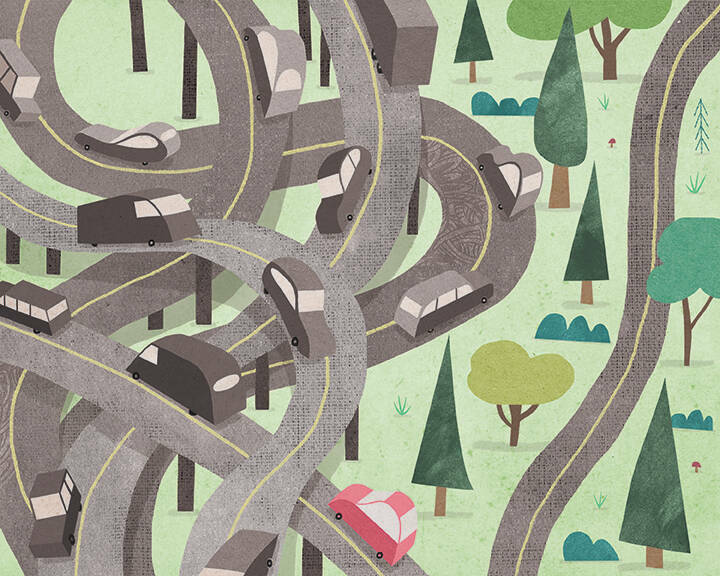 Illustration by Joe Anderson
Illustration by Joe Anderson
Weekdays I drive through the world’s worst intersection. A left turn from Thompson Street onto Patterson Avenue requires me to navigate a short, two-way segment of a third street, Kensington. If Thompson and Patterson are two sides of a right triangle, Kensington is its hypotenuse. Rather than a simple, 90-degree left turn at a traffic signal, I need to make two 45-degree turns, the second against a flow of oncoming cars.
I need those cars to leave a gap for me to cross through. As they approach, I wonder: Are the drivers local? Do they know this place? Crossing requires the same finesse as managing a cranky appliance. I picture a placard set atop a toilet for guests: “Jiggle the handle three times and hold it down.” In the absence of signage, do the drivers know they need to leave me an opening?
When a gap occurs and I make my break, the sight line to my right is obscured not only by the traffic queue I am crossing but also — thanks to the arc of my trajectory — by my own passenger seat. Lacking the neck extensibility of a giraffe, I lean away from the backrest and crane my head to check for oncoming traffic.
I’ve driven this route for five years, mostly on my way home from work. And more confounding than the traffic flow is the fact that I have not yet pursued an alternative. Instead, just as I routinely flip down my visor whenever I drive along a sunny street, I have adjusted my mental angle to deal with this intersection’s unpleasant particularities. My complaints start like a song as I drive up Thompson. I shake my head to the refrain but do not change the station. Although I’m free to steer my way home by other roads, I never do so.
The intersection of Thompson and Patterson belongs to that category of things in my life that are bad but have not reached the tipping point of prompting change. It’s like the divot in my thumbnail that has thus far escaped clipping, or the light fixture at the top of my stairs — two out of three bulbs have burned out, but the dimness hasn’t yet caused me to trip. Or it’s like the spoon I use for breakfast. It’s been down the garbage disposal so frequently that its ridged edge bristles my mouth. I will choose a smoother-edged spoon if one is available. But since the utensil supply in my household is only so deep, I prefer to keep this imperfect spoon until I go spoon shopping, which is unlikely to occur anytime soon.
I likewise experience the discomfort of my commute without taking the initiative to explore my options. Mutterings and rising blood pressure are my most meaningful responses. I suspect any other route would add at least five minutes to my drive — too great an inconvenience.
A community garden abuts the intersection. It burgeons with the green, lifegiving bounty inherent to such places. Along the perimeter of the garden fence are fig trees and a sign that proclaims in large, red letters, “WARNING: FIGS ARE FOR GARDEN MEMBERS WHO LEASE PLOTS.” Beneath that in smaller font: “IF YOU PICK OUR FIGS, PLEASE MAKE A DONATION TO OUR GARDEN THROUGH VENMO,” followed by an account name. It’s a curious juxtaposition: a prohibition followed by instructions for violators to follow.
Like the roads we drive — even when signposts are provided — life does not always make it apparent how we should proceed. Sometimes we find ourselves on paths that are neither ideal nor recommended but are nonetheless possible.
Erin Buckley lives in Richmond, Virginia, where she works as an occupational therapist.